Cross Cultural Management Report: Leadership in Diverse Cultures
VerifiedAdded on 2020/05/11
|30
|8545
|51
Report
AI Summary
This report delves into the multifaceted realm of cross-cultural management, exploring its core concepts, relevant issues, and the impact of globalization. It examines the emergence of corporate social responsibility within this context, outlining research aims, methodologies, and key challenges. The report provides a detailed overview of cross-cultural leadership, human resource management, and the influence of management styles. It also analyzes the evolution of cross-cultural management models, including Hofstede's cultural dimensions, and addresses criticisms of these models. Furthermore, the report investigates the types of cross-cultural groups, popular topics in the field, and the application of statistical tools for empirical research. It concludes with a discussion of limitations and future research directions, providing a comprehensive understanding of this critical area of management.
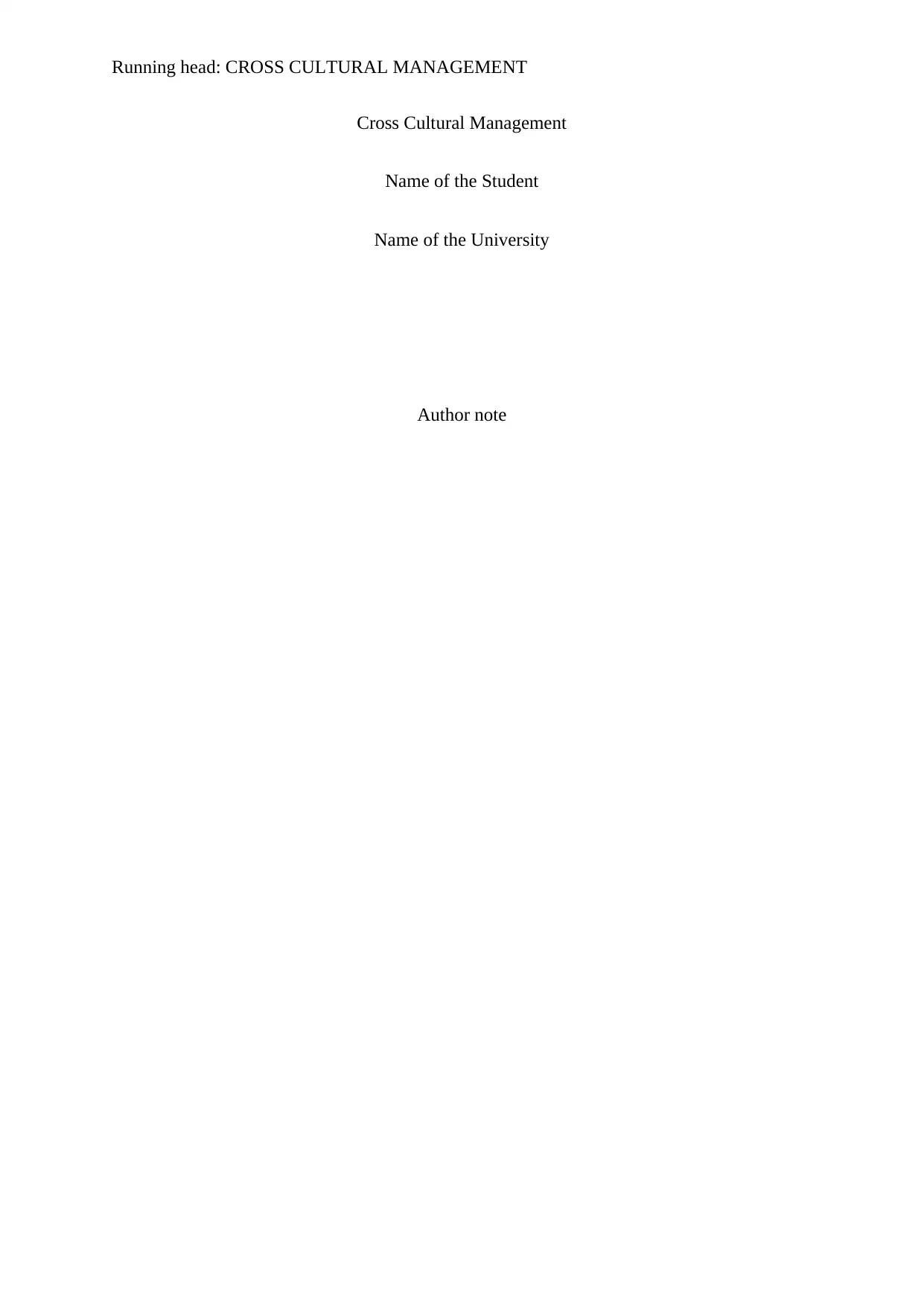
Running head: CROSS CULTURAL MANAGEMENT
Cross Cultural Management
Name of the Student
Name of the University
Author note
Cross Cultural Management
Name of the Student
Name of the University
Author note
Paraphrase This Document
Need a fresh take? Get an instant paraphrase of this document with our AI Paraphraser
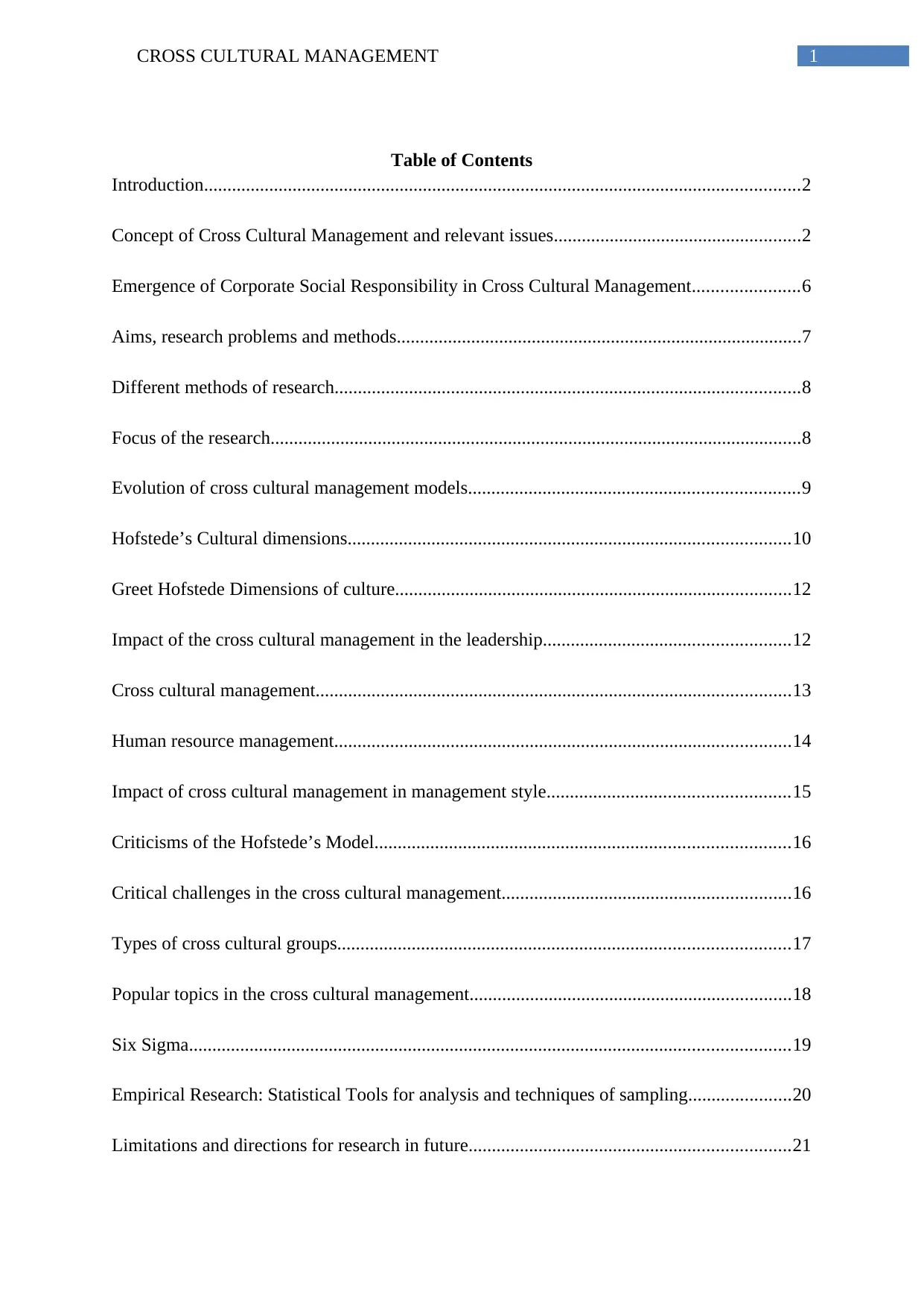
1CROSS CULTURAL MANAGEMENT
Table of Contents
Introduction................................................................................................................................2
Concept of Cross Cultural Management and relevant issues.....................................................2
Emergence of Corporate Social Responsibility in Cross Cultural Management.......................6
Aims, research problems and methods.......................................................................................7
Different methods of research....................................................................................................8
Focus of the research..................................................................................................................8
Evolution of cross cultural management models.......................................................................9
Hofstede’s Cultural dimensions...............................................................................................10
Greet Hofstede Dimensions of culture.....................................................................................12
Impact of the cross cultural management in the leadership.....................................................12
Cross cultural management......................................................................................................13
Human resource management..................................................................................................14
Impact of cross cultural management in management style....................................................15
Criticisms of the Hofstede’s Model.........................................................................................16
Critical challenges in the cross cultural management..............................................................16
Types of cross cultural groups.................................................................................................17
Popular topics in the cross cultural management.....................................................................18
Six Sigma.................................................................................................................................19
Empirical Research: Statistical Tools for analysis and techniques of sampling......................20
Limitations and directions for research in future.....................................................................21
Table of Contents
Introduction................................................................................................................................2
Concept of Cross Cultural Management and relevant issues.....................................................2
Emergence of Corporate Social Responsibility in Cross Cultural Management.......................6
Aims, research problems and methods.......................................................................................7
Different methods of research....................................................................................................8
Focus of the research..................................................................................................................8
Evolution of cross cultural management models.......................................................................9
Hofstede’s Cultural dimensions...............................................................................................10
Greet Hofstede Dimensions of culture.....................................................................................12
Impact of the cross cultural management in the leadership.....................................................12
Cross cultural management......................................................................................................13
Human resource management..................................................................................................14
Impact of cross cultural management in management style....................................................15
Criticisms of the Hofstede’s Model.........................................................................................16
Critical challenges in the cross cultural management..............................................................16
Types of cross cultural groups.................................................................................................17
Popular topics in the cross cultural management.....................................................................18
Six Sigma.................................................................................................................................19
Empirical Research: Statistical Tools for analysis and techniques of sampling......................20
Limitations and directions for research in future.....................................................................21
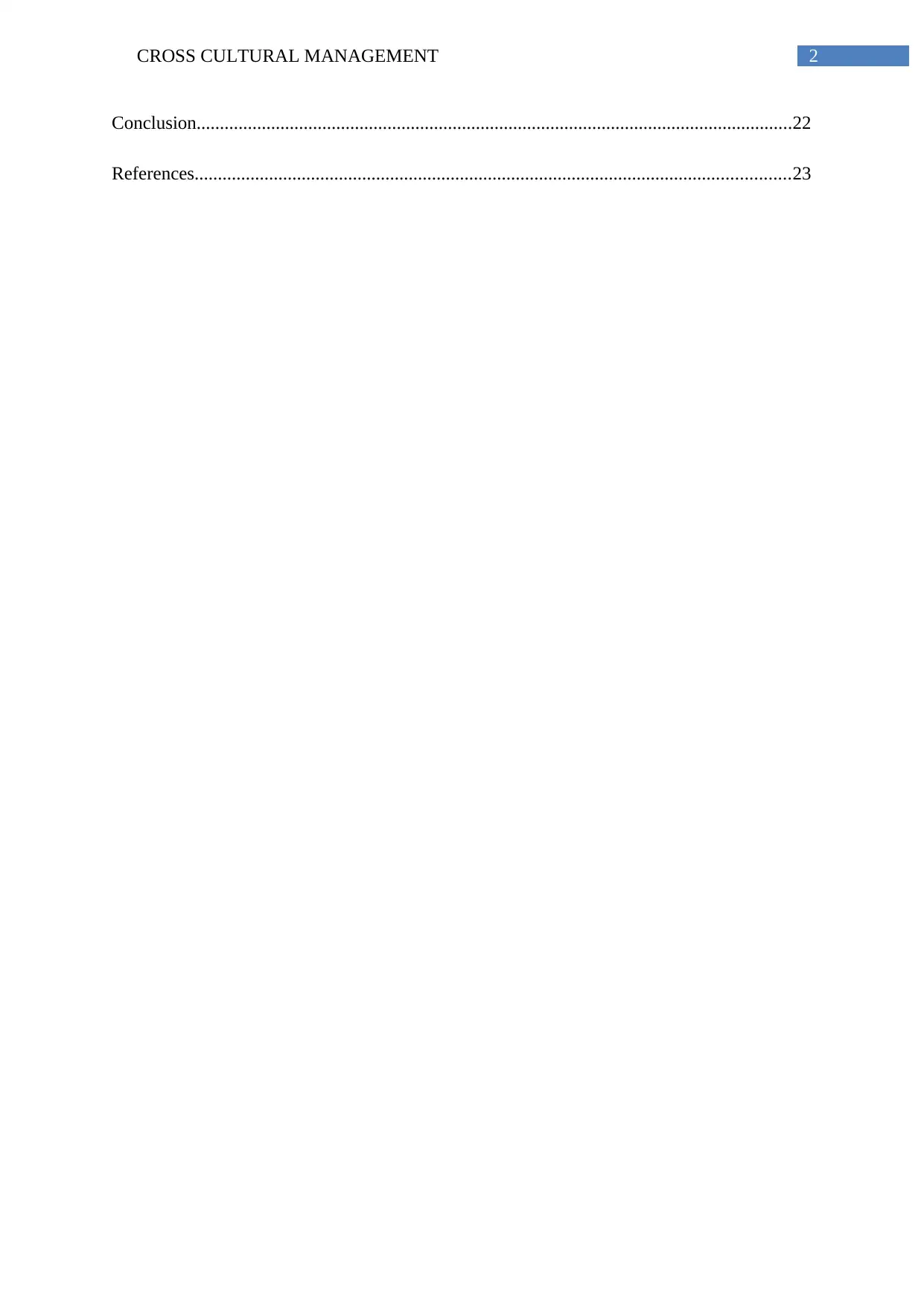
2CROSS CULTURAL MANAGEMENT
Conclusion................................................................................................................................22
References................................................................................................................................23
Conclusion................................................................................................................................22
References................................................................................................................................23
⊘ This is a preview!⊘
Do you want full access?
Subscribe today to unlock all pages.

Trusted by 1+ million students worldwide
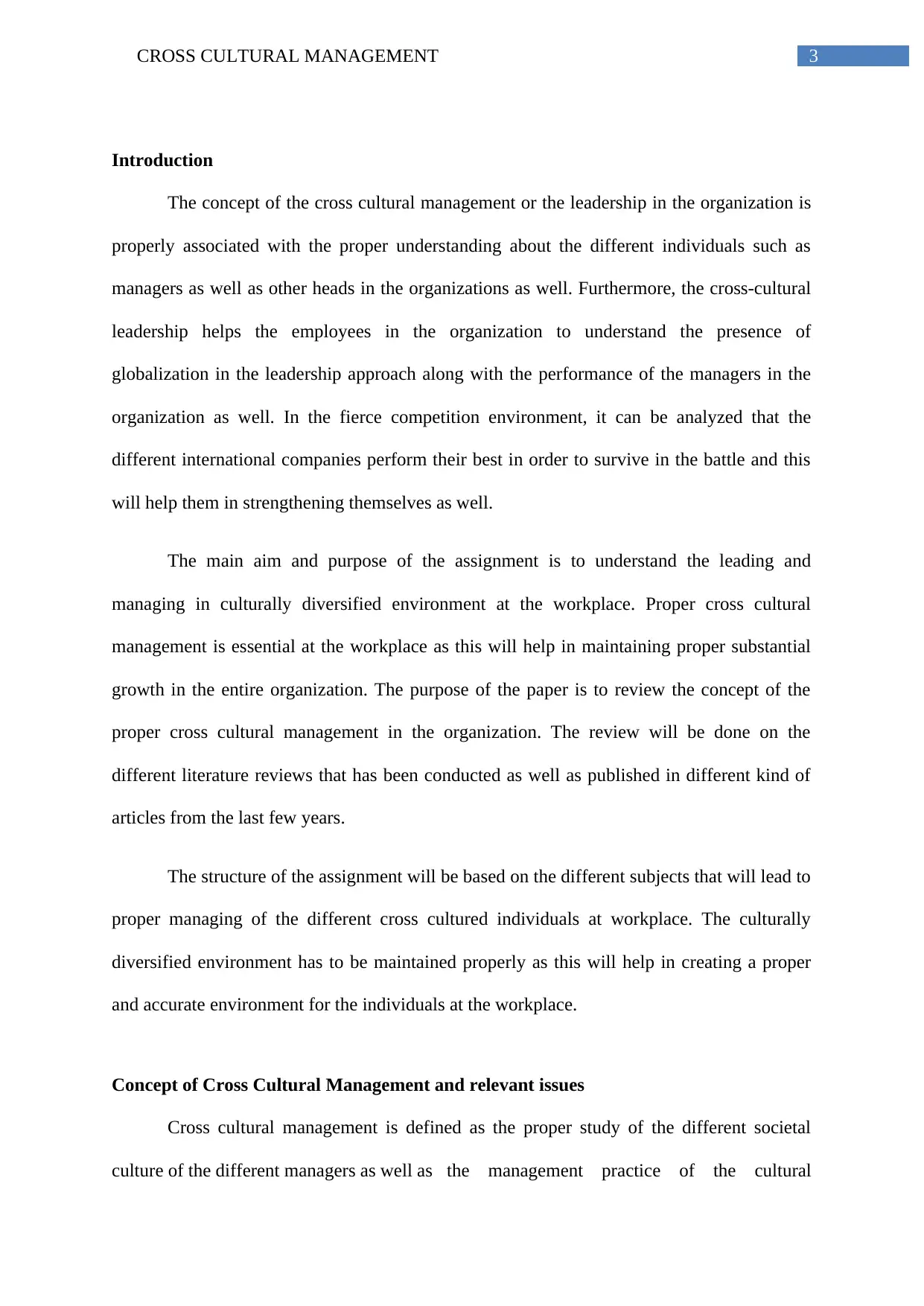
3CROSS CULTURAL MANAGEMENT
Introduction
The concept of the cross cultural management or the leadership in the organization is
properly associated with the proper understanding about the different individuals such as
managers as well as other heads in the organizations as well. Furthermore, the cross-cultural
leadership helps the employees in the organization to understand the presence of
globalization in the leadership approach along with the performance of the managers in the
organization as well. In the fierce competition environment, it can be analyzed that the
different international companies perform their best in order to survive in the battle and this
will help them in strengthening themselves as well.
The main aim and purpose of the assignment is to understand the leading and
managing in culturally diversified environment at the workplace. Proper cross cultural
management is essential at the workplace as this will help in maintaining proper substantial
growth in the entire organization. The purpose of the paper is to review the concept of the
proper cross cultural management in the organization. The review will be done on the
different literature reviews that has been conducted as well as published in different kind of
articles from the last few years.
The structure of the assignment will be based on the different subjects that will lead to
proper managing of the different cross cultured individuals at workplace. The culturally
diversified environment has to be maintained properly as this will help in creating a proper
and accurate environment for the individuals at the workplace.
Concept of Cross Cultural Management and relevant issues
Cross cultural management is defined as the proper study of the different societal
culture of the different managers as well as the management practice of the cultural
Introduction
The concept of the cross cultural management or the leadership in the organization is
properly associated with the proper understanding about the different individuals such as
managers as well as other heads in the organizations as well. Furthermore, the cross-cultural
leadership helps the employees in the organization to understand the presence of
globalization in the leadership approach along with the performance of the managers in the
organization as well. In the fierce competition environment, it can be analyzed that the
different international companies perform their best in order to survive in the battle and this
will help them in strengthening themselves as well.
The main aim and purpose of the assignment is to understand the leading and
managing in culturally diversified environment at the workplace. Proper cross cultural
management is essential at the workplace as this will help in maintaining proper substantial
growth in the entire organization. The purpose of the paper is to review the concept of the
proper cross cultural management in the organization. The review will be done on the
different literature reviews that has been conducted as well as published in different kind of
articles from the last few years.
The structure of the assignment will be based on the different subjects that will lead to
proper managing of the different cross cultured individuals at workplace. The culturally
diversified environment has to be maintained properly as this will help in creating a proper
and accurate environment for the individuals at the workplace.
Concept of Cross Cultural Management and relevant issues
Cross cultural management is defined as the proper study of the different societal
culture of the different managers as well as the management practice of the cultural
Paraphrase This Document
Need a fresh take? Get an instant paraphrase of this document with our AI Paraphraser
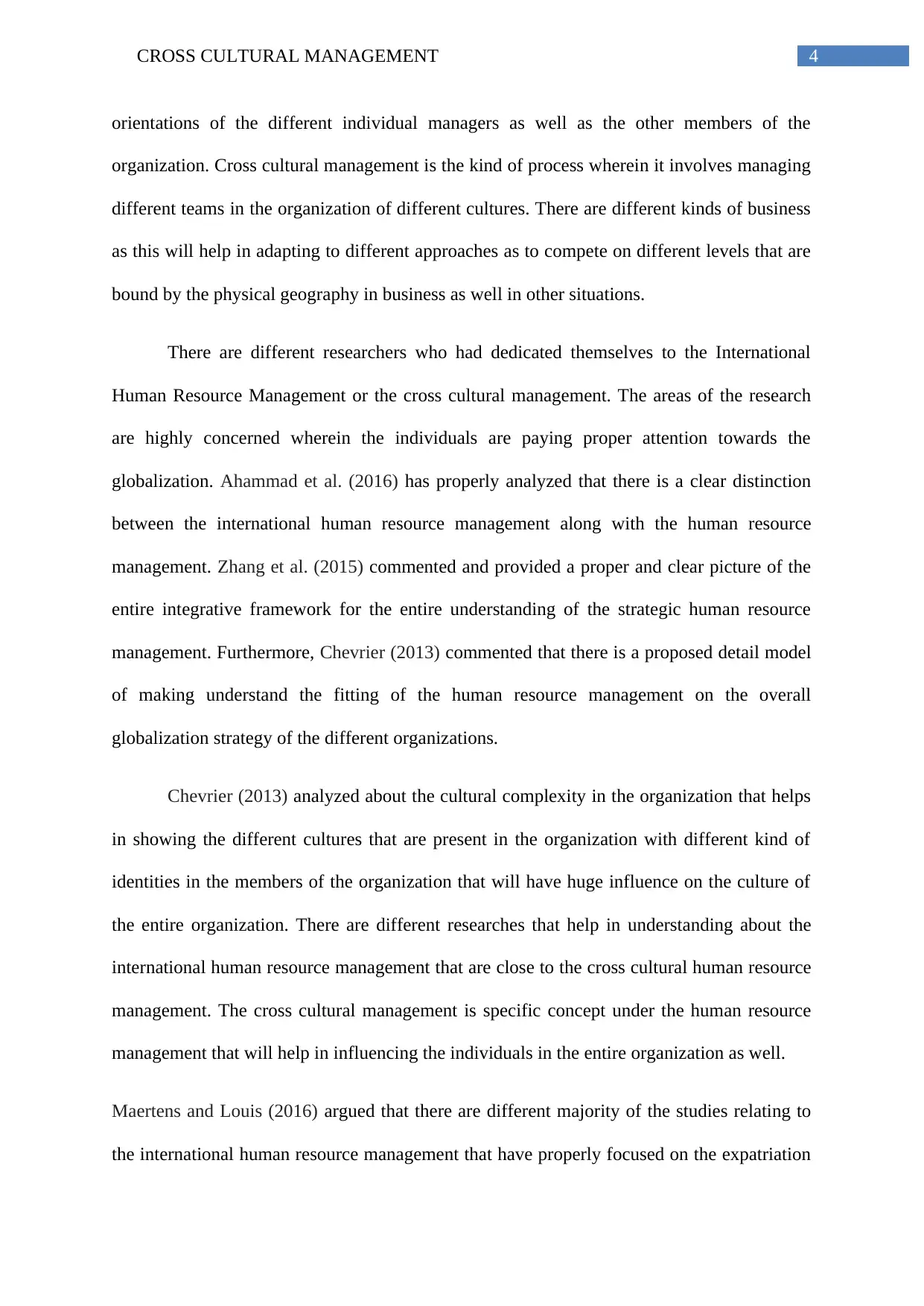
4CROSS CULTURAL MANAGEMENT
orientations of the different individual managers as well as the other members of the
organization. Cross cultural management is the kind of process wherein it involves managing
different teams in the organization of different cultures. There are different kinds of business
as this will help in adapting to different approaches as to compete on different levels that are
bound by the physical geography in business as well in other situations.
There are different researchers who had dedicated themselves to the International
Human Resource Management or the cross cultural management. The areas of the research
are highly concerned wherein the individuals are paying proper attention towards the
globalization. Ahammad et al. (2016) has properly analyzed that there is a clear distinction
between the international human resource management along with the human resource
management. Zhang et al. (2015) commented and provided a proper and clear picture of the
entire integrative framework for the entire understanding of the strategic human resource
management. Furthermore, Chevrier (2013) commented that there is a proposed detail model
of making understand the fitting of the human resource management on the overall
globalization strategy of the different organizations.
Chevrier (2013) analyzed about the cultural complexity in the organization that helps
in showing the different cultures that are present in the organization with different kind of
identities in the members of the organization that will have huge influence on the culture of
the entire organization. There are different researches that help in understanding about the
international human resource management that are close to the cross cultural human resource
management. The cross cultural management is specific concept under the human resource
management that will help in influencing the individuals in the entire organization as well.
Maertens and Louis (2016) argued that there are different majority of the studies relating to
the international human resource management that have properly focused on the expatriation
orientations of the different individual managers as well as the other members of the
organization. Cross cultural management is the kind of process wherein it involves managing
different teams in the organization of different cultures. There are different kinds of business
as this will help in adapting to different approaches as to compete on different levels that are
bound by the physical geography in business as well in other situations.
There are different researchers who had dedicated themselves to the International
Human Resource Management or the cross cultural management. The areas of the research
are highly concerned wherein the individuals are paying proper attention towards the
globalization. Ahammad et al. (2016) has properly analyzed that there is a clear distinction
between the international human resource management along with the human resource
management. Zhang et al. (2015) commented and provided a proper and clear picture of the
entire integrative framework for the entire understanding of the strategic human resource
management. Furthermore, Chevrier (2013) commented that there is a proposed detail model
of making understand the fitting of the human resource management on the overall
globalization strategy of the different organizations.
Chevrier (2013) analyzed about the cultural complexity in the organization that helps
in showing the different cultures that are present in the organization with different kind of
identities in the members of the organization that will have huge influence on the culture of
the entire organization. There are different researches that help in understanding about the
international human resource management that are close to the cross cultural human resource
management. The cross cultural management is specific concept under the human resource
management that will help in influencing the individuals in the entire organization as well.
Maertens and Louis (2016) argued that there are different majority of the studies relating to
the international human resource management that have properly focused on the expatriation
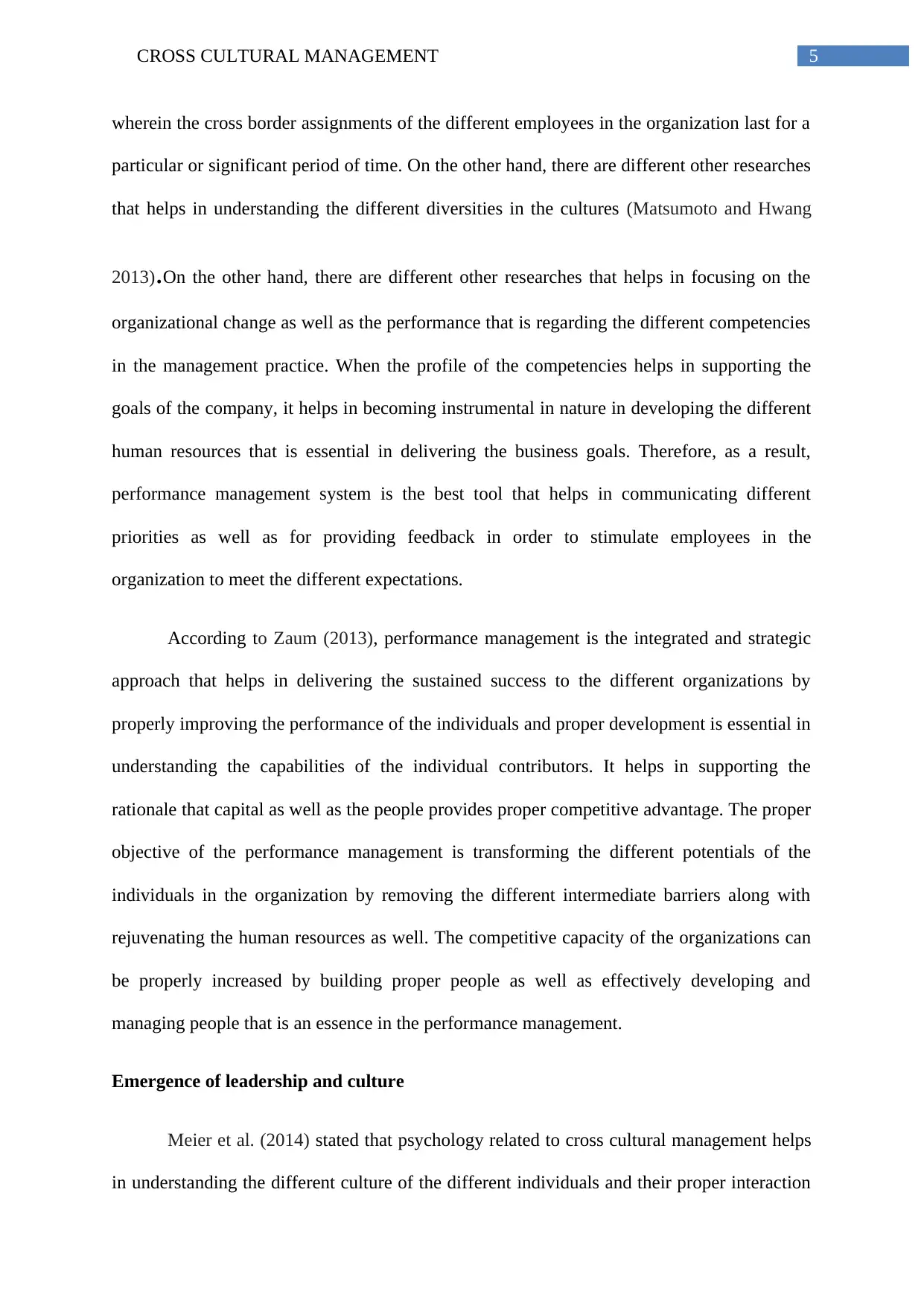
5CROSS CULTURAL MANAGEMENT
wherein the cross border assignments of the different employees in the organization last for a
particular or significant period of time. On the other hand, there are different other researches
that helps in understanding the different diversities in the cultures (Matsumoto and Hwang
2013).On the other hand, there are different other researches that helps in focusing on the
organizational change as well as the performance that is regarding the different competencies
in the management practice. When the profile of the competencies helps in supporting the
goals of the company, it helps in becoming instrumental in nature in developing the different
human resources that is essential in delivering the business goals. Therefore, as a result,
performance management system is the best tool that helps in communicating different
priorities as well as for providing feedback in order to stimulate employees in the
organization to meet the different expectations.
According to Zaum (2013), performance management is the integrated and strategic
approach that helps in delivering the sustained success to the different organizations by
properly improving the performance of the individuals and proper development is essential in
understanding the capabilities of the individual contributors. It helps in supporting the
rationale that capital as well as the people provides proper competitive advantage. The proper
objective of the performance management is transforming the different potentials of the
individuals in the organization by removing the different intermediate barriers along with
rejuvenating the human resources as well. The competitive capacity of the organizations can
be properly increased by building proper people as well as effectively developing and
managing people that is an essence in the performance management.
Emergence of leadership and culture
Meier et al. (2014) stated that psychology related to cross cultural management helps
in understanding the different culture of the different individuals and their proper interaction
wherein the cross border assignments of the different employees in the organization last for a
particular or significant period of time. On the other hand, there are different other researches
that helps in understanding the different diversities in the cultures (Matsumoto and Hwang
2013).On the other hand, there are different other researches that helps in focusing on the
organizational change as well as the performance that is regarding the different competencies
in the management practice. When the profile of the competencies helps in supporting the
goals of the company, it helps in becoming instrumental in nature in developing the different
human resources that is essential in delivering the business goals. Therefore, as a result,
performance management system is the best tool that helps in communicating different
priorities as well as for providing feedback in order to stimulate employees in the
organization to meet the different expectations.
According to Zaum (2013), performance management is the integrated and strategic
approach that helps in delivering the sustained success to the different organizations by
properly improving the performance of the individuals and proper development is essential in
understanding the capabilities of the individual contributors. It helps in supporting the
rationale that capital as well as the people provides proper competitive advantage. The proper
objective of the performance management is transforming the different potentials of the
individuals in the organization by removing the different intermediate barriers along with
rejuvenating the human resources as well. The competitive capacity of the organizations can
be properly increased by building proper people as well as effectively developing and
managing people that is an essence in the performance management.
Emergence of leadership and culture
Meier et al. (2014) stated that psychology related to cross cultural management helps
in understanding the different culture of the different individuals and their proper interaction
⊘ This is a preview!⊘
Do you want full access?
Subscribe today to unlock all pages.

Trusted by 1+ million students worldwide
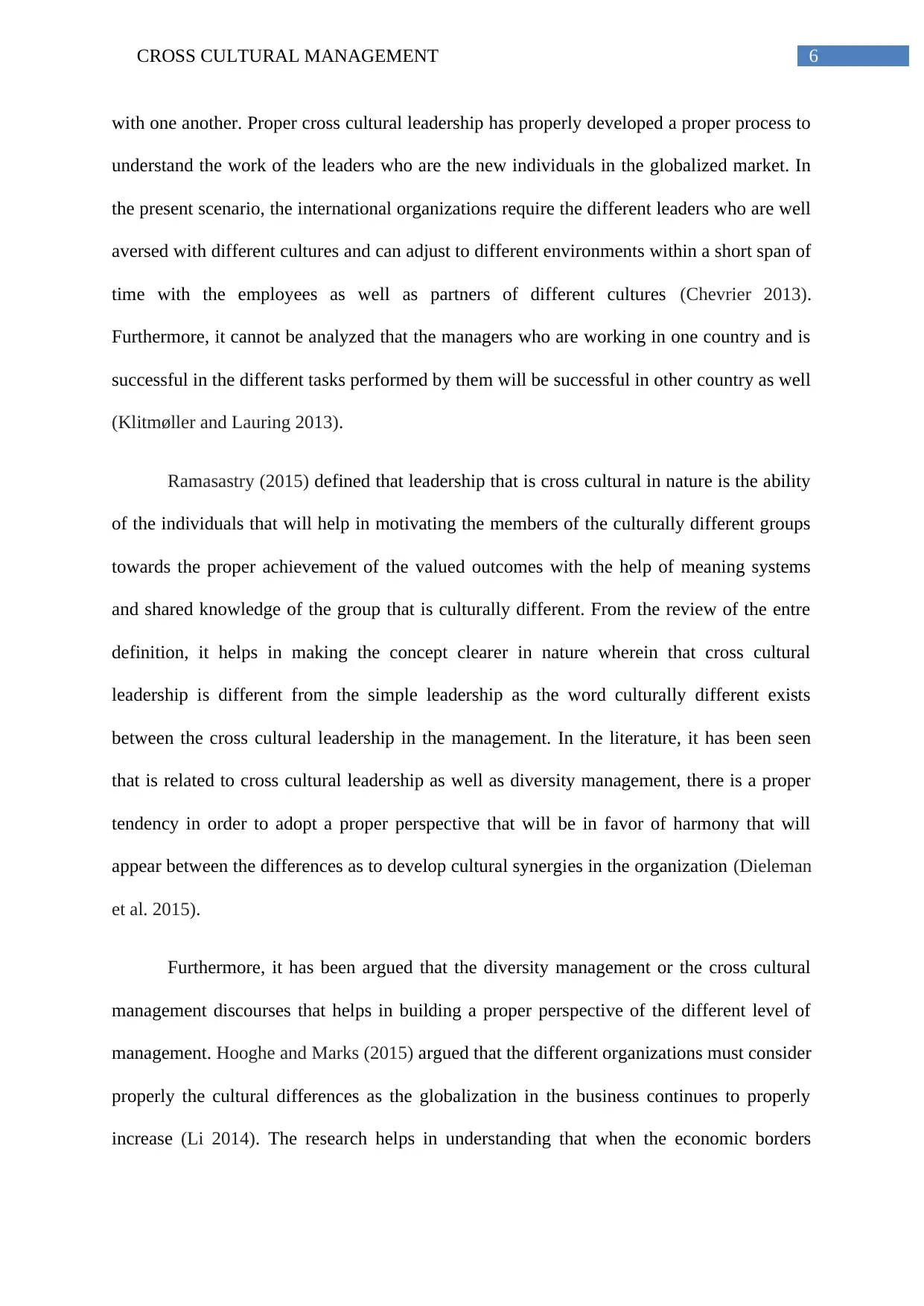
6CROSS CULTURAL MANAGEMENT
with one another. Proper cross cultural leadership has properly developed a proper process to
understand the work of the leaders who are the new individuals in the globalized market. In
the present scenario, the international organizations require the different leaders who are well
aversed with different cultures and can adjust to different environments within a short span of
time with the employees as well as partners of different cultures (Chevrier 2013).
Furthermore, it cannot be analyzed that the managers who are working in one country and is
successful in the different tasks performed by them will be successful in other country as well
(Klitmøller and Lauring 2013).
Ramasastry (2015) defined that leadership that is cross cultural in nature is the ability
of the individuals that will help in motivating the members of the culturally different groups
towards the proper achievement of the valued outcomes with the help of meaning systems
and shared knowledge of the group that is culturally different. From the review of the entre
definition, it helps in making the concept clearer in nature wherein that cross cultural
leadership is different from the simple leadership as the word culturally different exists
between the cross cultural leadership in the management. In the literature, it has been seen
that is related to cross cultural leadership as well as diversity management, there is a proper
tendency in order to adopt a proper perspective that will be in favor of harmony that will
appear between the differences as to develop cultural synergies in the organization (Dieleman
et al. 2015).
Furthermore, it has been argued that the diversity management or the cross cultural
management discourses that helps in building a proper perspective of the different level of
management. Hooghe and Marks (2015) argued that the different organizations must consider
properly the cultural differences as the globalization in the business continues to properly
increase (Li 2014). The research helps in understanding that when the economic borders
with one another. Proper cross cultural leadership has properly developed a proper process to
understand the work of the leaders who are the new individuals in the globalized market. In
the present scenario, the international organizations require the different leaders who are well
aversed with different cultures and can adjust to different environments within a short span of
time with the employees as well as partners of different cultures (Chevrier 2013).
Furthermore, it cannot be analyzed that the managers who are working in one country and is
successful in the different tasks performed by them will be successful in other country as well
(Klitmøller and Lauring 2013).
Ramasastry (2015) defined that leadership that is cross cultural in nature is the ability
of the individuals that will help in motivating the members of the culturally different groups
towards the proper achievement of the valued outcomes with the help of meaning systems
and shared knowledge of the group that is culturally different. From the review of the entre
definition, it helps in making the concept clearer in nature wherein that cross cultural
leadership is different from the simple leadership as the word culturally different exists
between the cross cultural leadership in the management. In the literature, it has been seen
that is related to cross cultural leadership as well as diversity management, there is a proper
tendency in order to adopt a proper perspective that will be in favor of harmony that will
appear between the differences as to develop cultural synergies in the organization (Dieleman
et al. 2015).
Furthermore, it has been argued that the diversity management or the cross cultural
management discourses that helps in building a proper perspective of the different level of
management. Hooghe and Marks (2015) argued that the different organizations must consider
properly the cultural differences as the globalization in the business continues to properly
increase (Li 2014). The research helps in understanding that when the economic borders
Paraphrase This Document
Need a fresh take? Get an instant paraphrase of this document with our AI Paraphraser
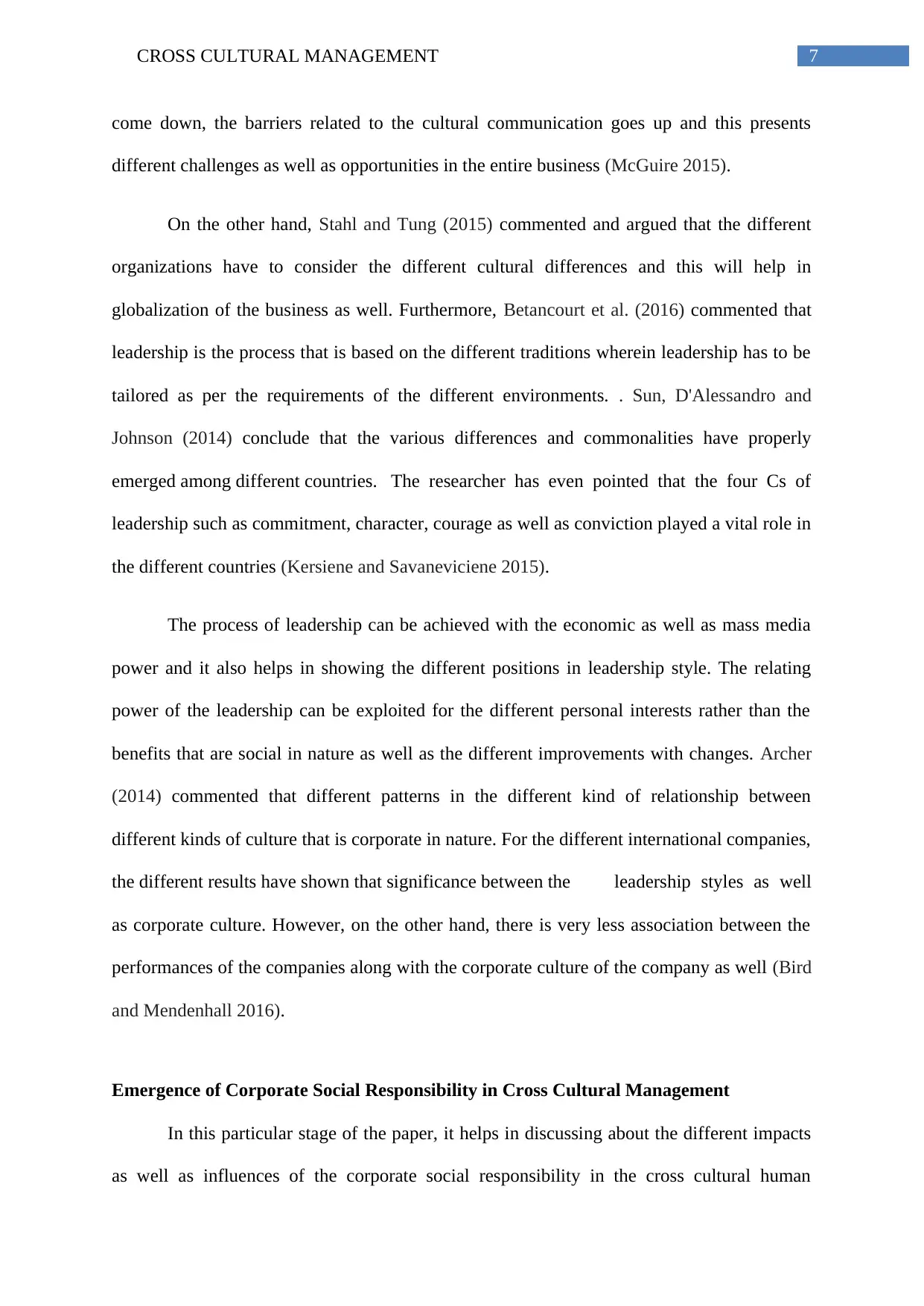
7CROSS CULTURAL MANAGEMENT
come down, the barriers related to the cultural communication goes up and this presents
different challenges as well as opportunities in the entire business (McGuire 2015).
On the other hand, Stahl and Tung (2015) commented and argued that the different
organizations have to consider the different cultural differences and this will help in
globalization of the business as well. Furthermore, Betancourt et al. (2016) commented that
leadership is the process that is based on the different traditions wherein leadership has to be
tailored as per the requirements of the different environments. . Sun, D'Alessandro and
Johnson (2014) conclude that the various differences and commonalities have properly
emerged among different countries. The researcher has even pointed that the four Cs of
leadership such as commitment, character, courage as well as conviction played a vital role in
the different countries (Kersiene and Savaneviciene 2015).
The process of leadership can be achieved with the economic as well as mass media
power and it also helps in showing the different positions in leadership style. The relating
power of the leadership can be exploited for the different personal interests rather than the
benefits that are social in nature as well as the different improvements with changes. Archer
(2014) commented that different patterns in the different kind of relationship between
different kinds of culture that is corporate in nature. For the different international companies,
the different results have shown that significance between the leadership styles as well
as corporate culture. However, on the other hand, there is very less association between the
performances of the companies along with the corporate culture of the company as well (Bird
and Mendenhall 2016).
Emergence of Corporate Social Responsibility in Cross Cultural Management
In this particular stage of the paper, it helps in discussing about the different impacts
as well as influences of the corporate social responsibility in the cross cultural human
come down, the barriers related to the cultural communication goes up and this presents
different challenges as well as opportunities in the entire business (McGuire 2015).
On the other hand, Stahl and Tung (2015) commented and argued that the different
organizations have to consider the different cultural differences and this will help in
globalization of the business as well. Furthermore, Betancourt et al. (2016) commented that
leadership is the process that is based on the different traditions wherein leadership has to be
tailored as per the requirements of the different environments. . Sun, D'Alessandro and
Johnson (2014) conclude that the various differences and commonalities have properly
emerged among different countries. The researcher has even pointed that the four Cs of
leadership such as commitment, character, courage as well as conviction played a vital role in
the different countries (Kersiene and Savaneviciene 2015).
The process of leadership can be achieved with the economic as well as mass media
power and it also helps in showing the different positions in leadership style. The relating
power of the leadership can be exploited for the different personal interests rather than the
benefits that are social in nature as well as the different improvements with changes. Archer
(2014) commented that different patterns in the different kind of relationship between
different kinds of culture that is corporate in nature. For the different international companies,
the different results have shown that significance between the leadership styles as well
as corporate culture. However, on the other hand, there is very less association between the
performances of the companies along with the corporate culture of the company as well (Bird
and Mendenhall 2016).
Emergence of Corporate Social Responsibility in Cross Cultural Management
In this particular stage of the paper, it helps in discussing about the different impacts
as well as influences of the corporate social responsibility in the cross cultural human
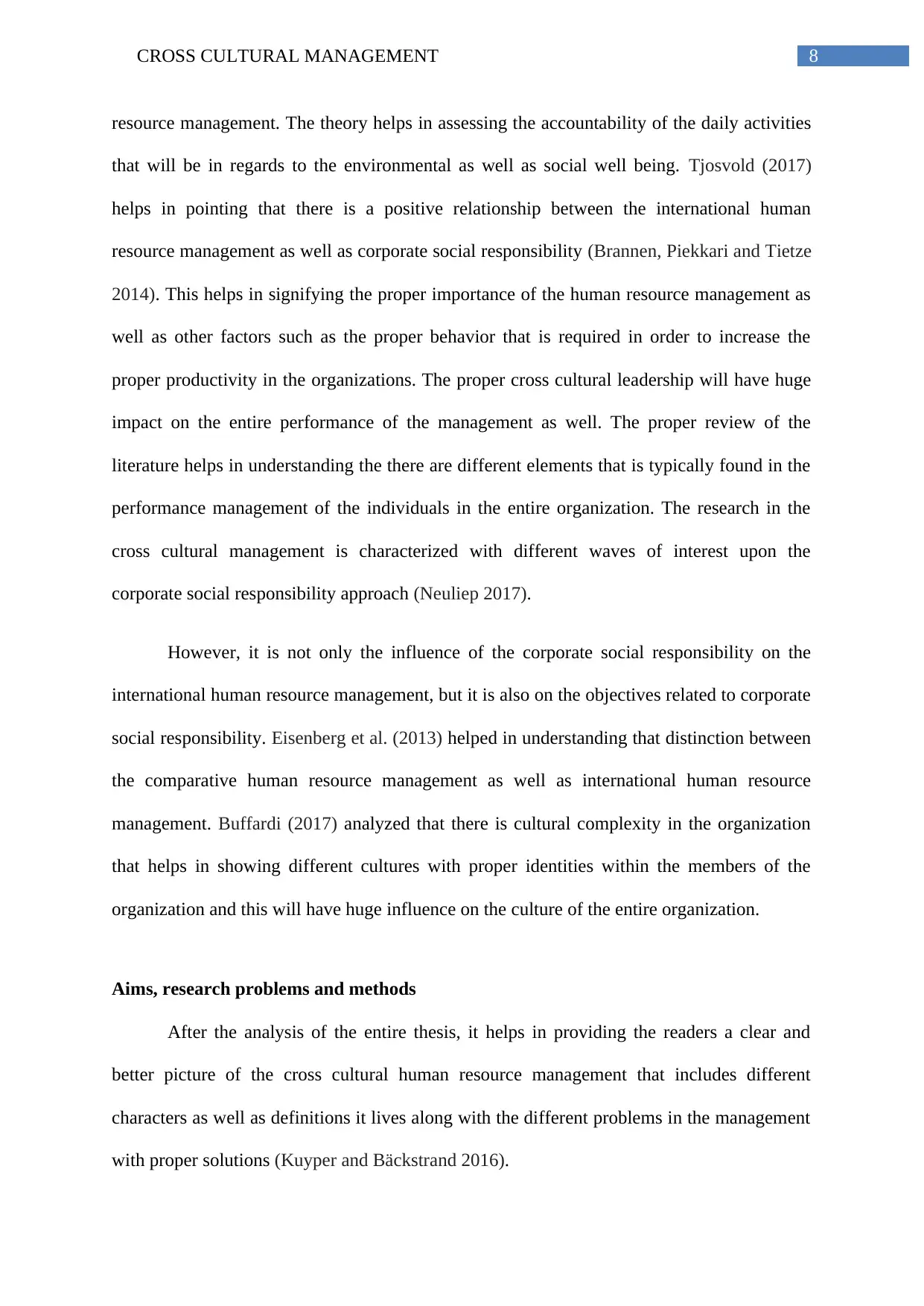
8CROSS CULTURAL MANAGEMENT
resource management. The theory helps in assessing the accountability of the daily activities
that will be in regards to the environmental as well as social well being. Tjosvold (2017)
helps in pointing that there is a positive relationship between the international human
resource management as well as corporate social responsibility (Brannen, Piekkari and Tietze
2014). This helps in signifying the proper importance of the human resource management as
well as other factors such as the proper behavior that is required in order to increase the
proper productivity in the organizations. The proper cross cultural leadership will have huge
impact on the entire performance of the management as well. The proper review of the
literature helps in understanding the there are different elements that is typically found in the
performance management of the individuals in the entire organization. The research in the
cross cultural management is characterized with different waves of interest upon the
corporate social responsibility approach (Neuliep 2017).
However, it is not only the influence of the corporate social responsibility on the
international human resource management, but it is also on the objectives related to corporate
social responsibility. Eisenberg et al. (2013) helped in understanding that distinction between
the comparative human resource management as well as international human resource
management. Buffardi (2017) analyzed that there is cultural complexity in the organization
that helps in showing different cultures with proper identities within the members of the
organization and this will have huge influence on the culture of the entire organization.
Aims, research problems and methods
After the analysis of the entire thesis, it helps in providing the readers a clear and
better picture of the cross cultural human resource management that includes different
characters as well as definitions it lives along with the different problems in the management
with proper solutions (Kuyper and Bäckstrand 2016).
resource management. The theory helps in assessing the accountability of the daily activities
that will be in regards to the environmental as well as social well being. Tjosvold (2017)
helps in pointing that there is a positive relationship between the international human
resource management as well as corporate social responsibility (Brannen, Piekkari and Tietze
2014). This helps in signifying the proper importance of the human resource management as
well as other factors such as the proper behavior that is required in order to increase the
proper productivity in the organizations. The proper cross cultural leadership will have huge
impact on the entire performance of the management as well. The proper review of the
literature helps in understanding the there are different elements that is typically found in the
performance management of the individuals in the entire organization. The research in the
cross cultural management is characterized with different waves of interest upon the
corporate social responsibility approach (Neuliep 2017).
However, it is not only the influence of the corporate social responsibility on the
international human resource management, but it is also on the objectives related to corporate
social responsibility. Eisenberg et al. (2013) helped in understanding that distinction between
the comparative human resource management as well as international human resource
management. Buffardi (2017) analyzed that there is cultural complexity in the organization
that helps in showing different cultures with proper identities within the members of the
organization and this will have huge influence on the culture of the entire organization.
Aims, research problems and methods
After the analysis of the entire thesis, it helps in providing the readers a clear and
better picture of the cross cultural human resource management that includes different
characters as well as definitions it lives along with the different problems in the management
with proper solutions (Kuyper and Bäckstrand 2016).
⊘ This is a preview!⊘
Do you want full access?
Subscribe today to unlock all pages.

Trusted by 1+ million students worldwide
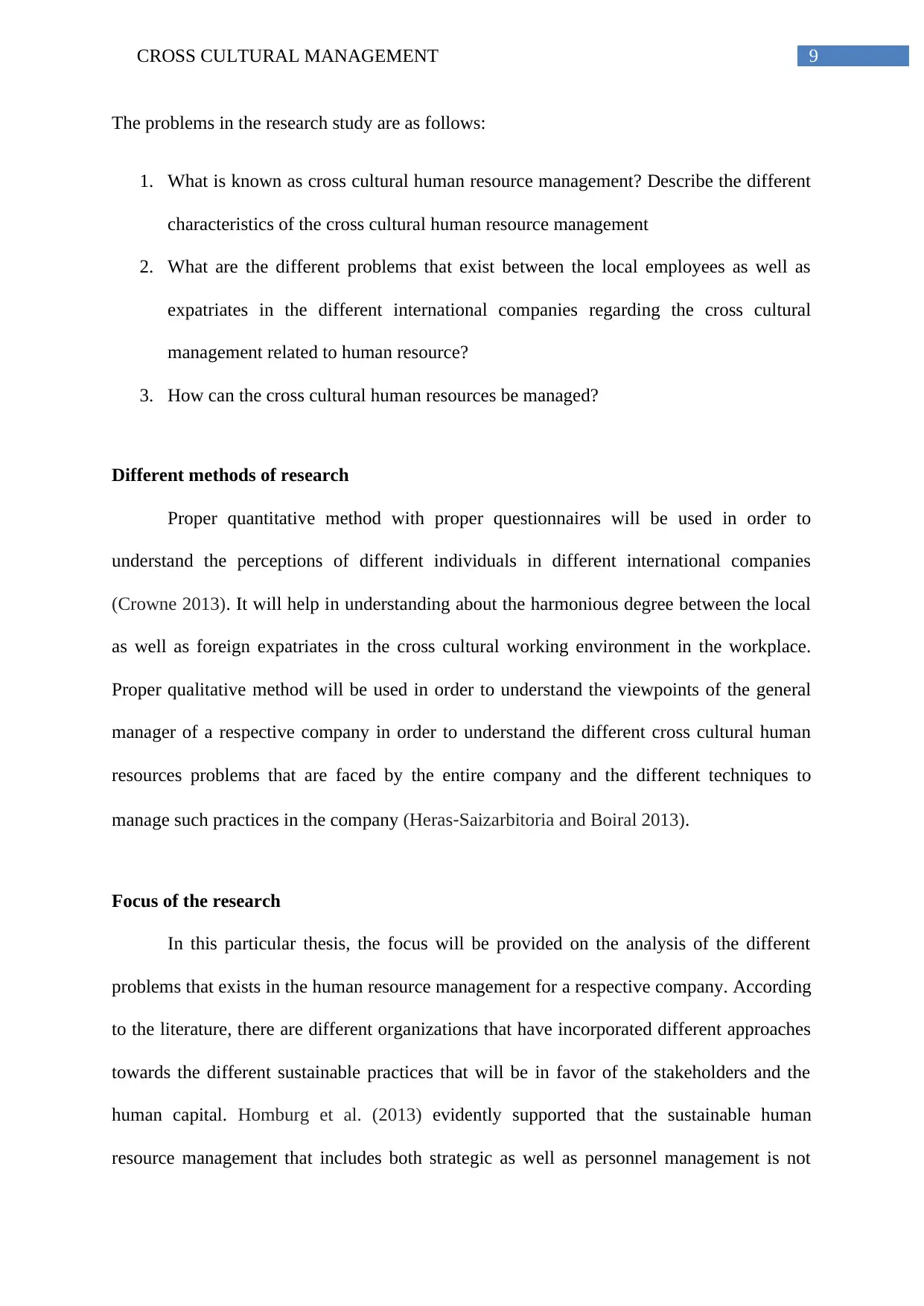
9CROSS CULTURAL MANAGEMENT
The problems in the research study are as follows:
1. What is known as cross cultural human resource management? Describe the different
characteristics of the cross cultural human resource management
2. What are the different problems that exist between the local employees as well as
expatriates in the different international companies regarding the cross cultural
management related to human resource?
3. How can the cross cultural human resources be managed?
Different methods of research
Proper quantitative method with proper questionnaires will be used in order to
understand the perceptions of different individuals in different international companies
(Crowne 2013). It will help in understanding about the harmonious degree between the local
as well as foreign expatriates in the cross cultural working environment in the workplace.
Proper qualitative method will be used in order to understand the viewpoints of the general
manager of a respective company in order to understand the different cross cultural human
resources problems that are faced by the entire company and the different techniques to
manage such practices in the company (Heras‐Saizarbitoria and Boiral 2013).
Focus of the research
In this particular thesis, the focus will be provided on the analysis of the different
problems that exists in the human resource management for a respective company. According
to the literature, there are different organizations that have incorporated different approaches
towards the different sustainable practices that will be in favor of the stakeholders and the
human capital. Homburg et al. (2013) evidently supported that the sustainable human
resource management that includes both strategic as well as personnel management is not
The problems in the research study are as follows:
1. What is known as cross cultural human resource management? Describe the different
characteristics of the cross cultural human resource management
2. What are the different problems that exist between the local employees as well as
expatriates in the different international companies regarding the cross cultural
management related to human resource?
3. How can the cross cultural human resources be managed?
Different methods of research
Proper quantitative method with proper questionnaires will be used in order to
understand the perceptions of different individuals in different international companies
(Crowne 2013). It will help in understanding about the harmonious degree between the local
as well as foreign expatriates in the cross cultural working environment in the workplace.
Proper qualitative method will be used in order to understand the viewpoints of the general
manager of a respective company in order to understand the different cross cultural human
resources problems that are faced by the entire company and the different techniques to
manage such practices in the company (Heras‐Saizarbitoria and Boiral 2013).
Focus of the research
In this particular thesis, the focus will be provided on the analysis of the different
problems that exists in the human resource management for a respective company. According
to the literature, there are different organizations that have incorporated different approaches
towards the different sustainable practices that will be in favor of the stakeholders and the
human capital. Homburg et al. (2013) evidently supported that the sustainable human
resource management that includes both strategic as well as personnel management is not
Paraphrase This Document
Need a fresh take? Get an instant paraphrase of this document with our AI Paraphraser
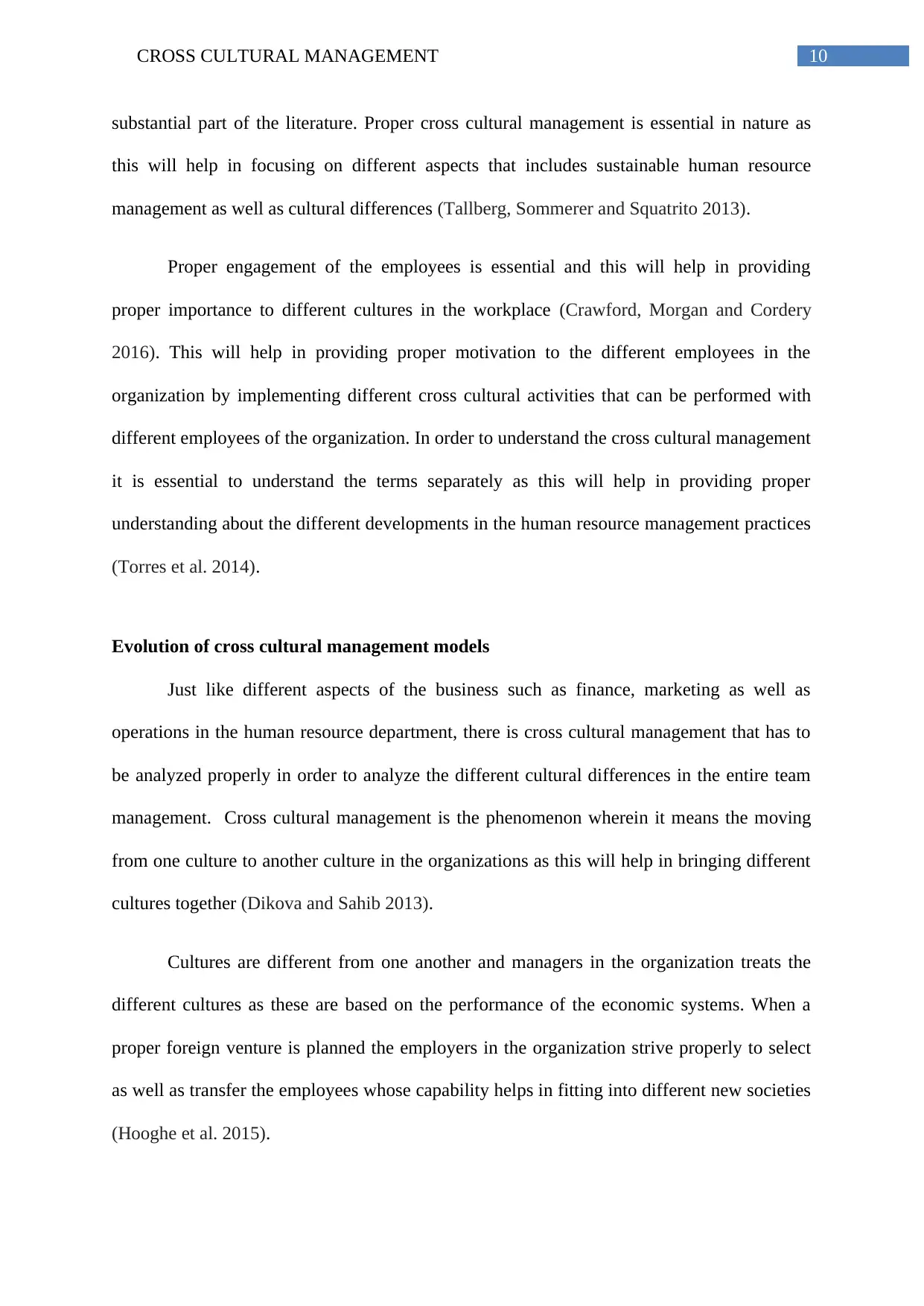
10CROSS CULTURAL MANAGEMENT
substantial part of the literature. Proper cross cultural management is essential in nature as
this will help in focusing on different aspects that includes sustainable human resource
management as well as cultural differences (Tallberg, Sommerer and Squatrito 2013).
Proper engagement of the employees is essential and this will help in providing
proper importance to different cultures in the workplace (Crawford, Morgan and Cordery
2016). This will help in providing proper motivation to the different employees in the
organization by implementing different cross cultural activities that can be performed with
different employees of the organization. In order to understand the cross cultural management
it is essential to understand the terms separately as this will help in providing proper
understanding about the different developments in the human resource management practices
(Torres et al. 2014).
Evolution of cross cultural management models
Just like different aspects of the business such as finance, marketing as well as
operations in the human resource department, there is cross cultural management that has to
be analyzed properly in order to analyze the different cultural differences in the entire team
management. Cross cultural management is the phenomenon wherein it means the moving
from one culture to another culture in the organizations as this will help in bringing different
cultures together (Dikova and Sahib 2013).
Cultures are different from one another and managers in the organization treats the
different cultures as these are based on the performance of the economic systems. When a
proper foreign venture is planned the employers in the organization strive properly to select
as well as transfer the employees whose capability helps in fitting into different new societies
(Hooghe et al. 2015).
substantial part of the literature. Proper cross cultural management is essential in nature as
this will help in focusing on different aspects that includes sustainable human resource
management as well as cultural differences (Tallberg, Sommerer and Squatrito 2013).
Proper engagement of the employees is essential and this will help in providing
proper importance to different cultures in the workplace (Crawford, Morgan and Cordery
2016). This will help in providing proper motivation to the different employees in the
organization by implementing different cross cultural activities that can be performed with
different employees of the organization. In order to understand the cross cultural management
it is essential to understand the terms separately as this will help in providing proper
understanding about the different developments in the human resource management practices
(Torres et al. 2014).
Evolution of cross cultural management models
Just like different aspects of the business such as finance, marketing as well as
operations in the human resource department, there is cross cultural management that has to
be analyzed properly in order to analyze the different cultural differences in the entire team
management. Cross cultural management is the phenomenon wherein it means the moving
from one culture to another culture in the organizations as this will help in bringing different
cultures together (Dikova and Sahib 2013).
Cultures are different from one another and managers in the organization treats the
different cultures as these are based on the performance of the economic systems. When a
proper foreign venture is planned the employers in the organization strive properly to select
as well as transfer the employees whose capability helps in fitting into different new societies
(Hooghe et al. 2015).
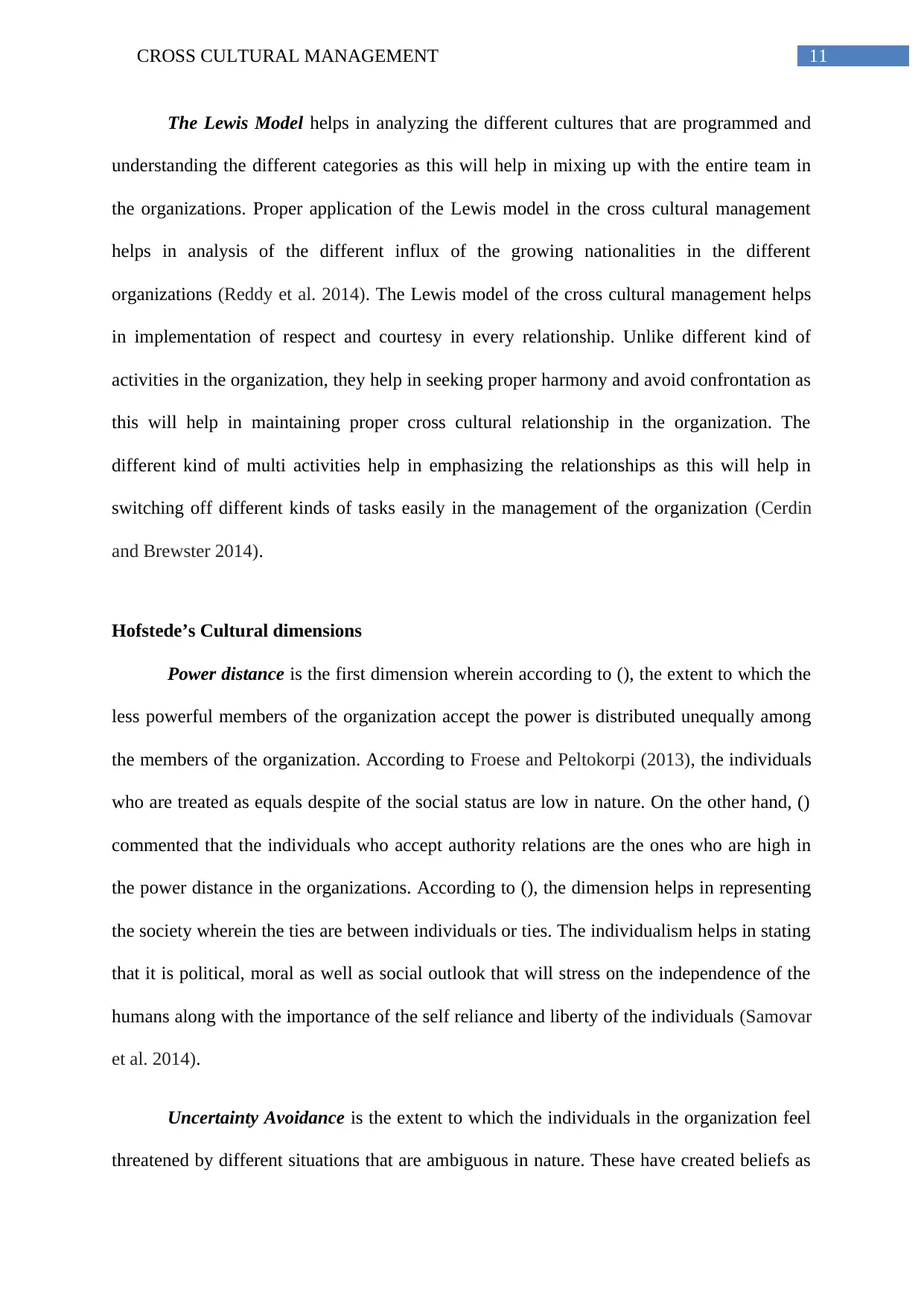
11CROSS CULTURAL MANAGEMENT
The Lewis Model helps in analyzing the different cultures that are programmed and
understanding the different categories as this will help in mixing up with the entire team in
the organizations. Proper application of the Lewis model in the cross cultural management
helps in analysis of the different influx of the growing nationalities in the different
organizations (Reddy et al. 2014). The Lewis model of the cross cultural management helps
in implementation of respect and courtesy in every relationship. Unlike different kind of
activities in the organization, they help in seeking proper harmony and avoid confrontation as
this will help in maintaining proper cross cultural relationship in the organization. The
different kind of multi activities help in emphasizing the relationships as this will help in
switching off different kinds of tasks easily in the management of the organization (Cerdin
and Brewster 2014).
Hofstede’s Cultural dimensions
Power distance is the first dimension wherein according to (), the extent to which the
less powerful members of the organization accept the power is distributed unequally among
the members of the organization. According to Froese and Peltokorpi (2013), the individuals
who are treated as equals despite of the social status are low in nature. On the other hand, ()
commented that the individuals who accept authority relations are the ones who are high in
the power distance in the organizations. According to (), the dimension helps in representing
the society wherein the ties are between individuals or ties. The individualism helps in stating
that it is political, moral as well as social outlook that will stress on the independence of the
humans along with the importance of the self reliance and liberty of the individuals (Samovar
et al. 2014).
Uncertainty Avoidance is the extent to which the individuals in the organization feel
threatened by different situations that are ambiguous in nature. These have created beliefs as
The Lewis Model helps in analyzing the different cultures that are programmed and
understanding the different categories as this will help in mixing up with the entire team in
the organizations. Proper application of the Lewis model in the cross cultural management
helps in analysis of the different influx of the growing nationalities in the different
organizations (Reddy et al. 2014). The Lewis model of the cross cultural management helps
in implementation of respect and courtesy in every relationship. Unlike different kind of
activities in the organization, they help in seeking proper harmony and avoid confrontation as
this will help in maintaining proper cross cultural relationship in the organization. The
different kind of multi activities help in emphasizing the relationships as this will help in
switching off different kinds of tasks easily in the management of the organization (Cerdin
and Brewster 2014).
Hofstede’s Cultural dimensions
Power distance is the first dimension wherein according to (), the extent to which the
less powerful members of the organization accept the power is distributed unequally among
the members of the organization. According to Froese and Peltokorpi (2013), the individuals
who are treated as equals despite of the social status are low in nature. On the other hand, ()
commented that the individuals who accept authority relations are the ones who are high in
the power distance in the organizations. According to (), the dimension helps in representing
the society wherein the ties are between individuals or ties. The individualism helps in stating
that it is political, moral as well as social outlook that will stress on the independence of the
humans along with the importance of the self reliance and liberty of the individuals (Samovar
et al. 2014).
Uncertainty Avoidance is the extent to which the individuals in the organization feel
threatened by different situations that are ambiguous in nature. These have created beliefs as
⊘ This is a preview!⊘
Do you want full access?
Subscribe today to unlock all pages.

Trusted by 1+ million students worldwide
1 out of 30
Related Documents
Your All-in-One AI-Powered Toolkit for Academic Success.
+13062052269
info@desklib.com
Available 24*7 on WhatsApp / Email
![[object Object]](/_next/static/media/star-bottom.7253800d.svg)
Unlock your academic potential
Copyright © 2020–2025 A2Z Services. All Rights Reserved. Developed and managed by ZUCOL.





